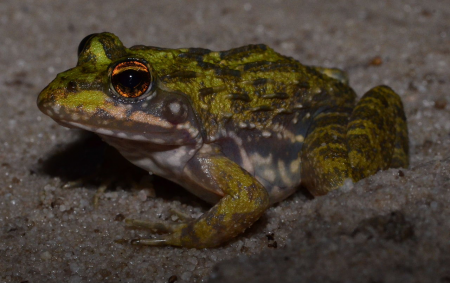FrogMAP — Frog Atlas of Southern Africa
Family Pyxicephalidae
Amietia fuscigula (Duméril and Bibron, 1841)
Cape River Frog, Dusky-throated Frog, Kaapse Rivierpadda (A)
Species account was published under the name:
Afrana fuscigula (Duméril and Bibron, 1841)
Red listing status: Least Concern (2017)

Photo by Hodgson Andrew & Heather, 2013. URL: FrogMAP: 639
Distribution
A. fuscigula is almost entirely restricted to the atlas region; the only extralimital populations occur in the Naukluft Mountains in Namibia. It is found at sea level in Western and Eastern Cape provinces, but generally at higher elevations elsewhere, with most records coming from the central plateau, excluding Swaziland. Records from the uplands of Lesotho almost certainly refer to A. dracomontana, while some historical data may be in error because of confusion with the superficially similar A. angolensis. A. fuscigula is widespread in the Karoo and atlas data are incomplete in that region.
Habitat
A. fuscigula inhabits mainly the Grassland and Fynbos biomes, but fragmented populations occur in the southwestern parts of the arid Succulent Karoo and Nama Karoo biomes. It occurs in both winter- and summer-rainfall areas, where annual precipitation ranges from 200 mm in the Karoo to >3000 mm on the Cape fold mountains. A. fuscigula uses the same habitat throughout the year. It is associated with permanent springs, ponds and farm dams in the dry northwest, while elsewhere it occurs along most well-vegetated waterways.
Life history
Breeding takes place throughout the year, with a peak in the rainy season. Males often call from the surface of deep water, and can be heard calling during the day and night. These frogs eat anything that comes within reach, mostly insects. Food records include a mouse, other frogs, including conspecific frogs, (Rose 1962) and crabs (Channing 1979).
Conservation
This widespread species is not threatened and no special conservation measures are needed. The records from springs in the dry northwest and from the Naukluft mountains in Namibia, suggest that A. fuscigula was more widely distributed in wetter times and that these are relict populations. The ecology and dynamics of populations in arid areas could provide interesting fields of study.
Current distribution map
 Undated records;
Undated records;  pre-1996;
pre-1996;  1996 to 2002;
1996 to 2002;  2003 to present
2003 to present
Citation:
- Web:
FrogMAP. 2024. Afrana fuscigula (Duméril and Bibron, 1841). Animal Demography Unit. Accessed from http://frogmap.adu.org.za/?sp=890; on 2024-04-26 10:04:44. - Book:
Minter L.R., Burger M., Harrison J.A., Braack H.H., Bishop P.J. & Kloepfer D. (eds). 2004. Atlas and Red Data book of the frogs of South Africa, Lesotho and Swaziland. SI/MAB Series no. 9. Smithsonian Institution, Washington, D.C. Published by the Smithsonian Institution and the Avian Demography Unit (now Animal Demography Unit).




